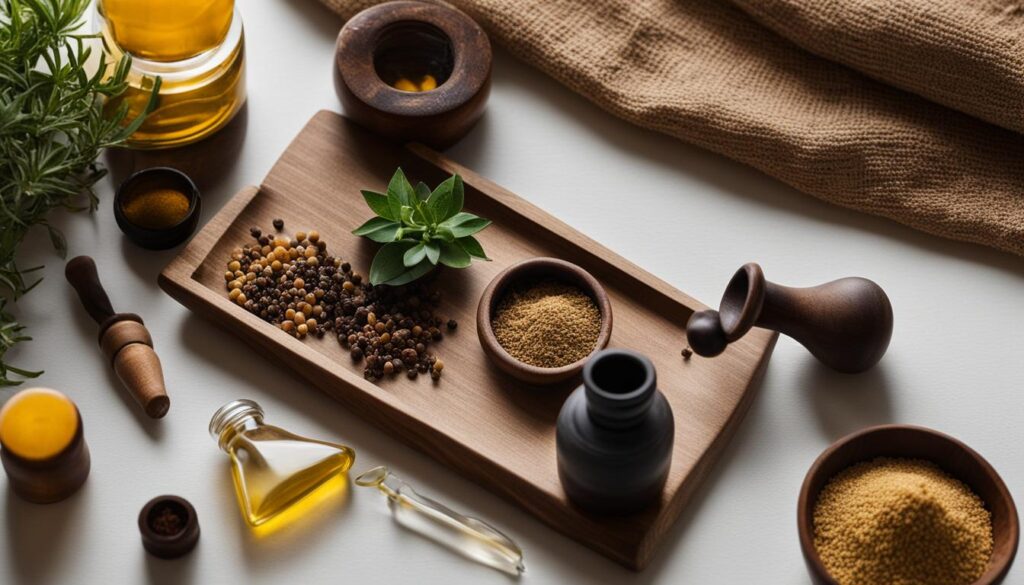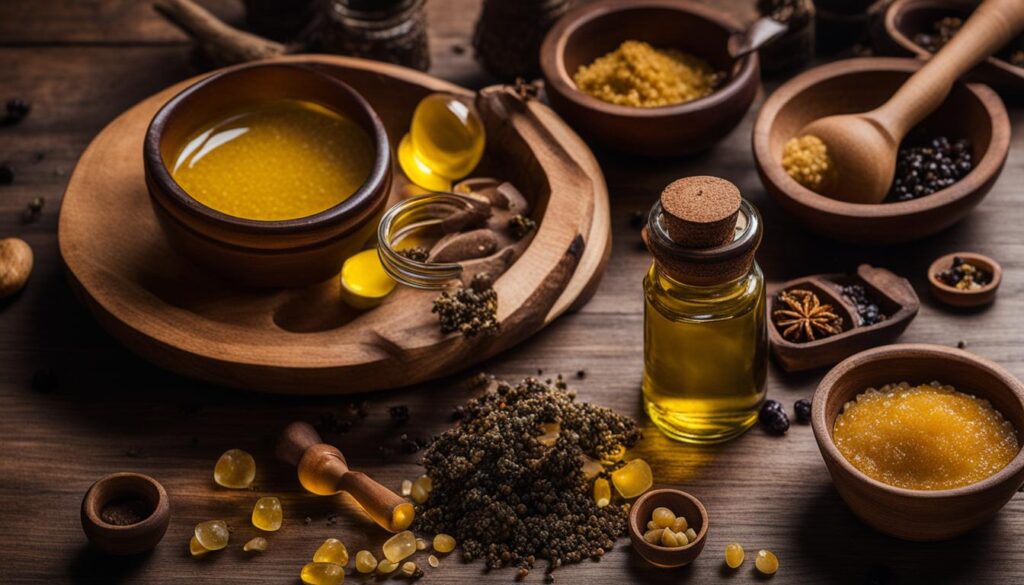Making your own frankincense oil can be a rewarding and cost-effective process. By following this easy DIY guide, you can learn how to create your own fragrant frankincense oil at home. With just a few ingredients and some simple steps, you’ll be able to enjoy the benefits of this versatile essential oil.
Key Takeaways:
- Learn how to make your own frankincense oil with this easy DIY guide.
- Enjoy the benefits of a pure and natural frankincense oil without any synthetic additives.
- Save money by making your own frankincense oil at home.
- Discover the versatility of frankincense oil and find different ways to incorporate it into your self-care routine.
- Experiment with different blends and uses to find what works best for you.
Why Make Your Own Frankincense Oil
Frankincense oil has many benefits for both the mind and body. It can help relax and calm the mind, making it a popular choice for aromatherapy. Additionally, frankincense oil has been studied for its potential health benefits and may have anti-inflammatory properties. By making your own frankincense oil, you can ensure that you are using a pure and natural product without any synthetic additives. Plus, it can be a fun and fulfilling DIY project to undertake.

Ingredients and Equipment Needed
To make your own frankincense oil at home, you will need a few essential ingredients and equipment. Here’s a comprehensive list of what you’ll require:
Ingredients:
- Frankincense Resin
- Safflower Oil
Equipment:
- Glass Container
- Mortar and Pestle
- Cheesecloth or Coffee Filter
- Dark Glass Bottle
Gathering these items beforehand will ensure a smooth and efficient process when making your own frankincense oil. Let’s take a closer look at each ingredient and equipment to better understand their role in the DIY process.

Starting with the main ingredient, Frankincense Resin, it can be easily purchased online or from specialty stores. High-quality resin will yield superior results, so invest in a reputable brand to ensure the authenticity and potency of the essential oil.
Next, the Safflower Oil acts as the carrier oil and provides a stable base for the frankincense oil. Safflower oil is a popular choice due to its mild aroma and skin-friendly properties.
You will also need a Glass Container to hold the frankincense resin and safflower oil mixture. Make sure the container is large enough to accommodate the ingredients comfortably and has a secure lid to prevent any spills or contamination.
A Mortar and Pestle or a similar tool is necessary to break down the frankincense resin into smaller pieces. This process helps release the aromatic compounds, allowing them to infuse with the safflower oil more effectively.
To strain the oil and remove any debris or residue, you will need either a Cheesecloth or a Coffee Filter. This ensures that the final product is pure and free from any impurities, resulting in a high-quality frankincense oil.
Finally, you will need a Dark Glass Bottle to store the finished oil. Dark glass bottles help protect the oil from light exposure, which can degrade its quality over time.
Step-by-Step Instructions
Follow these step-by-step instructions to make frankincense oil at home.
- Lightly crack the frankincense resin using a mortar and pestle. Be careful not to turn it into a powder, but rather break it down into smaller pieces.
- Pour safflower oil into a jar, leaving enough room for the resin.
- Add the cracked resin to the oil and stir well.
- Close the jar tightly and place it in a sunny spot, such as a windowsill, for two days, shaking it periodically.
- After two days, strain the mixture through a cheesecloth or coffee filter to remove the resin.
- Transfer the oil to a dark glass bottle for storage.
Tips and Tricks
When it comes to making your own homemade frankincense oil, following these tips and tricks will ensure the best results. Whether you’re a beginner or an experienced DIY enthusiast, these insights will help you create high-quality frankincense essential oil that you can enjoy and share with others.
1. Clean and Sterilize
Before you start the frankincense oil making process, it’s important to clean and sterilize all your materials and equipment. This will help prevent any contamination and ensure the longevity of your homemade oil. Proper sterilization can be achieved by washing your glass container, mortar and pestle, and other tools with hot, soapy water. Rinse thoroughly and allow them to air dry completely before use.
2. Choose High-Quality Frankincense Resin
The quality of your frankincense resin will directly impact the final quality of your homemade oil. Look for reputable suppliers and choose premium-grade frankincense resin that is pure and free from any impurities. This will result in a more potent and aromatic oil that captures the true essence of frankincense.
3. Enhance Strength with Fresh Resin
If you prefer a stronger frankincense oil, you can repeat the extraction process using fresh resin and the oil you’ve already made. By infusing the oil with additional resin, you can intensify its fragrance and therapeutic properties. Experiment with the ratio of resin to oil to find the perfect balance that suits your preferences.
4. Store in a Cool, Dark Place
To preserve the potency and shelf life of your homemade frankincense oil, store it in a cool, dark place away from direct sunlight and heat sources. Exposure to light and heat can degrade the oil and diminish its fragrance and therapeutic benefits. A dark glass bottle is ideal for storage as it helps protect the oil from harmful UV rays.
5. Label and Date Your Bottles
“Labeling and dating your frankincense oil bottles not only helps you keep track of their freshness but also adds a professional touch to your homemade creations.”
By labeling and dating your bottles, you’ll always know the extraction date of your oil and can use them in the right order to ensure freshness. It also adds a personal touch if you plan to give your homemade frankincense oil as a gift or sell it to others. Use waterproof labels and permanent markers to avoid smudging or fading over time.
By following these tips and tricks, you’ll be able to make homemade frankincense oil that is of the highest quality and captures the true essence of this precious essential oil. Feel free to experiment and customize your frankincense oil-making process to suit your preferences and needs.

Uses and Benefits of Frankincense Oil
Frankincense oil is a versatile and beneficial essential oil with a wide range of uses. One of its key applications is in skincare, where it can be used topically for its anti-inflammatory properties. Apply a few drops of frankincense oil to soothe and heal the skin, helping to reduce redness and irritation.
In addition to skincare, frankincense oil can be incorporated into various self-care products. Add a few drops to your favorite skincare products, such as moisturizers or serums, to enhance their rejuvenating and anti-aging effects. Alternatively, mix frankincense oil with a carrier oil, such as jojoba or coconut oil, to create a luxurious massage oil that promotes relaxation and leaves your skin feeling nourished.
Another popular use for frankincense oil is in aromatherapy. Its calming and grounding properties make it ideal for reducing stress and promoting a sense of tranquility. Add a few drops of frankincense oil to your diffuser or inhale it directly from the bottle to create a peaceful atmosphere in your home or workspace.
Beyond its topical and aromatic applications, studies suggest that frankincense oil may have potential health benefits. It has been found to possess anti-inflammatory properties, which may aid in reducing inflammation in the body. By incorporating frankincense oil into your self-care routine, you can support your overall well-being and experience the myriad benefits this essential oil has to offer.
FAQ
How can I make frankincense oil at home?
To make frankincense oil at home, you will need frankincense resin, safflower oil, a glass container, a mortar and pestle, and a cheesecloth or coffee filter. Crack the resin, mix it with the oil, let it sit for two days, then strain and store the oil.
What are the benefits of making my own frankincense oil?
Making your own frankincense oil ensures that you are using a pure and natural product without any synthetic additives. It can also be a fun and fulfilling DIY project to undertake.
What ingredients and equipment do I need to make frankincense oil?
You will need frankincense resin, safflower oil, a glass container, a mortar and pestle, and a cheesecloth or coffee filter. A dark glass bottle is also necessary for storing the finished oil.
What are the step-by-step instructions for making frankincense oil at home?
Lightly crack the frankincense resin using a mortar and pestle. Pour safflower oil into a glass container, add the cracked resin, and stir well. Let the mixture sit in a sunny spot for two days, shaking it periodically. After two days, strain the oil through a cheesecloth or coffee filter and transfer it to a dark glass bottle.
What are some tips and tricks for making the best frankincense oil?
Ensure that all your materials and equipment are clean and sterile. Use high-quality frankincense resin for better results. If you want a stronger oil, you can repeat the process with fresh resin and the oil you’ve already made. Store the oil in a cool, dark place to preserve its shelf life.
How can I use frankincense oil?
Frankincense oil can be used topically for its anti-inflammatory properties, added to skincare products for its rejuvenating effects, or used in aromatherapy to promote relaxation and reduce stress. It may also have potential health benefits, such as reducing inflammation and supporting overall well-being.






